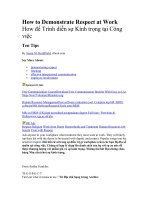Applications at work the app culture, IT and the business
Bạn đang xem bản rút gọn của tài liệu. Xem và tải ngay bản đầy đủ của tài liệu tại đây (136.59 KB, 2 trang )
Applications
at work
The “app culture”, IT and the business*
Written by The Economist Intelligence Unit
The right application
A
In organisations, technology decisions are no longer the
monopoly of the information technology department. Whereas
the corporate IT budget used to be funnelled almost entirely
through the chief information officer (CIO) or chief technology
officer (CTO), research firm Gartner predicts that by 2015, only 60%
of technology expenditure will be managed centrally.1 Research
conducted by The Economist Intelligence Unit (EIU) in early 2013 also
found that business units in almost half (46%) of companies globally
consult IT about a technology decision less than half the time.2 Such
decisions may be about purchasing a mobile device, sourcing an office
productivity tool or application, or accessing a cloud-based service,
among other things.
The phenomenon known as “shadow IT” (in which parts of the business
obtain and operate software or hardware without recourse to the IT
department) is emerging from the murk, becoming a standard part
of how the business procures and uses technology. The purchase and
development of applications, including mobile apps, is part of this
trend. An “app culture” is developing in which employees feel able—
and empowered—to identify and obtain the software they feel they
need to do the job. Some feel capable of developing the applications
themselves.
*This and other articles about the challenges and
opportunities of mobility, sponsored by EE, can be found at
/>“Gartner Outsourcing Summit 2013: How digitisation is shaking up IT outsourcing”,
Computer Weekly.com, September 10, 2013.
2
“Freedom to choose: What technology autonomy means for the business”, a
Bluecoat report written by The Economist Intelligence Unit, June 2013.
1
The BYOD (bring your own device) trend is naturally one driver of this
activity. As employees increasingly use their own smartphone, laptop
or tablet to conduct their work, they, their managers and their direct
colleagues are becoming familiar with the various types of applications
that can help them be more productive. In this sense, BYOD has led to
the growth of BYOA (bring your own application).
Another factor is dissatisfaction with the time some IT departments
take to procure and deploy applications and devices. “Making a request
of IT can take three months, even for a simple addition to the website,”
comments a senior executive at a London hospital. “Meanwhile, nurses
and clinicians are downloading apps to help them in their day-to-day
duties.”
So lines of business are increasingly choosing to purchase or build
applications, mobile or otherwise, for their own needs. The marketing
department accounts for much of this activity, reflecting the evolving
ways that companies are engaging with their customers. Sales and
operational departments—particularly in the business-to-business
sector—are also looking to create apps for their own staff, such
as account managers and service teams. According to Laith Clark,
managing director of mobile app development company TapMob: “We
see a lot of activity where commercial or free apps and services aren’t
really aligned with how the business works. Businesses have to choose
whether to take an off-the-shelf app and use it as best they can, or to
invest more money up front and get all the information they need.”
For business units, the benefit of developing or purchasing applications
themselves, rather than relying on IT, can be lower up-front cost and
the (usually) reduced time spent in deploying the app. It also means
the department can work in terms it understands. For example, the
marketing department may have a contractual relationship with a
digital agency and can express an app requirement in terms of a brief,
rather than having to think in terms of a technical specification.
Bring your own complexity
There are naturally downsides and risks. “Marketing can ask for what
they think is a quite simple front end, without too much thought about
the back-end systems or questions such as data security,” says Mr
s p o n s o r ed by :
Clarke. “These can require spending a lot of money on data integration,
or can create issues which cause problems later. For example, a
client-facing application for use at trade shows may be designed to
synchronise data on prospects at the end of the day—but what happens
if it gets stolen in the meantime?”
From the CIO’s perspective, departments taking such decisions into
their own hands—without always thinking of the ramifications—can
lead to increased complexity, cost and risk. If something goes wrong—
if corporate data is ‘leaked’ because of a poorly built app, for example—
the buck still stops with IT.
How are CIOs reacting to demands for such technology autonomy? In
the aforementioned EIU research, nine in ten CIOs and CTOs agreed
with the statement that “greater freedom for business units to make
technology decisions is critical if the business is to grow”. If anything,
they appear more convinced on this score than their business unit
peers. Many certainly see risks in terms of cost, complexity and
security, but most appear calm with expanding technology autonomy
and a fast-developing app culture.
The chief enabler
Simon Short, CTO and head of digital services at Capgemini UK, a
technology consultancy, sees two types of CIOs. “You’ve got the ones
who are still fighting the battle to lock everything down, to keep
control, to disallow ‘bring your own device’ and the accessing of
[external technology] services. And there is another type, who says
‘Our job is about enablement.’”
In their mission as business enablers, CIOs and IT departments clearly
have more to gain from the flourishing of an app culture in their
organisation than from its suppression. Freedom to build or buy the
application most suited to their business needs, provided security and
other standards are maintained, should be a boon to business units’
creativity and productivity. “This is a fantastic opportunity for CIOs,”
maintains Mr Short, speaking of the “bring your own” movement.
“They should embrace it.”









